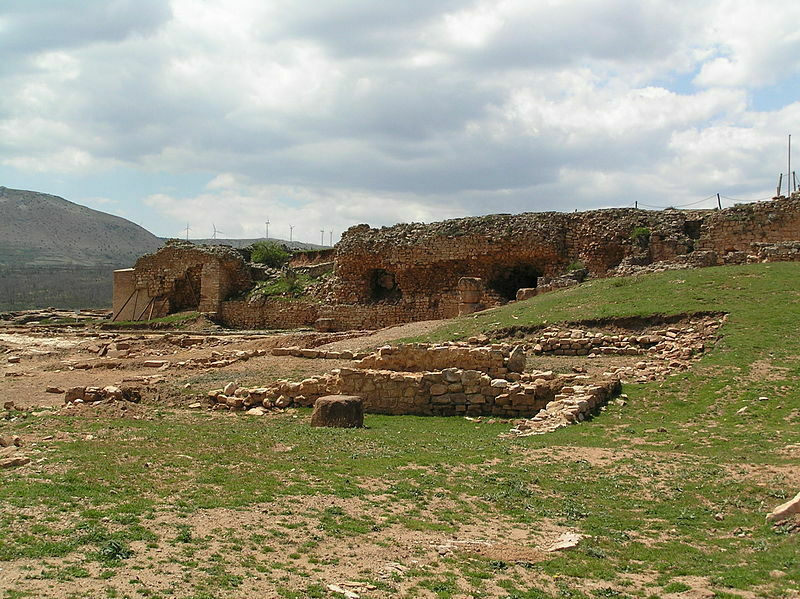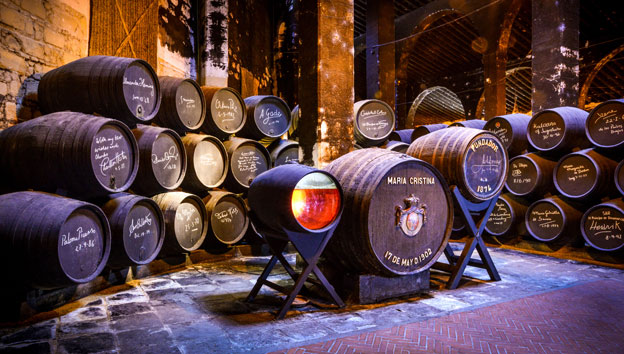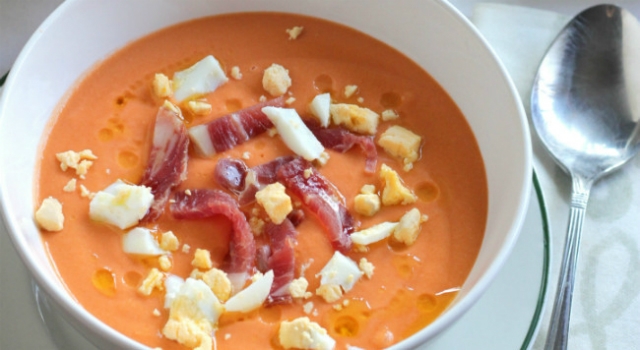Tiermes - An Iron Age Hill Fort
Friday, June 30, 2023

During the iron age, what is now the Tiermes Archaeological Site was a Celtiberian hill fort that was initially capable of resisting an assault by the Roman invaders.
The tribe occupying the site were allied to the Numantia tribe during the second century BC. In 98 BC, with the Numantia already overcome, Tiermes was captured by the Roman consul Titus Didius, beginning the slow but sure Romanisation of Tiermes.
_08.jpeg)

The urbanization of the area accelerated around 70 BC, and by the end of the first century, the city reached the height of its splendour. As you can see at the site today, it once boasted large public buildings, two fora, an aqueduct, and extensive urban development. Uniquely, these buildings were carved directly into the sandstone bluffs—an earlier Celtiberian practice but with Roman architecture covering the open frontages.

_05.jpeg)
A city wall was later built, and Tiermes remained in use until the 4th century after the decline of the Western Roman Empire. Today a number of archaeological remains can be seen, including an amazing water supply system that would have been capable of carrying 71 litres per second. There is also a small number of archaeological artefacts from the Visigoth and Muslim periods of the site that followed the Roman occupation.
 0
Like
Published at 10:19 PM Comments (0)
0
Like
Published at 10:19 PM Comments (0)
England's Love Affair with Sherry
Friday, June 23, 2023

Sherry, a fortified wine hailing from the Jerez region of Spain, has long been a favorite of British palates. Let's delve into the rich history of England's relationship with Sherry, tracing its origins, development, and current status in the world of wine.
Origins: The Early Days of Sherry in England
The love affair between England and Sherry began in the 12th century when the Moors, who ruled the Iberian Peninsula, introduced the wine to the British. The connection was further solidified in 1340 when the English fleet, led by Edward III, captured Jerez and its surrounding areas. The British quickly developed a taste for the local wine, which they called "sherris sack," a precursor to the modern term "sherry."
In 1587, Sir Francis Drake famously raided the Spanish port of Cádiz, seizing over 2,900 barrels of sherry and introducing it to a wider English audience. This event marked the beginning of a strong commercial relationship between England and the Jerez region, with sherry becoming a popular import and a staple of British drinking culture.
The Golden Age: 18th and 19th Centuries
The 18th and 19th centuries saw an explosion in the popularity of sherry in England. British merchants, such as the House of Sandeman, established bodegas (wine cellars) in Jerez and began exporting large quantities of sherry to England. The wine's popularity was further boosted by the rise of the British Empire, which expanded its reach across the globe, taking sherry along with it.
During this time, sherry became an essential part of British social life. It was consumed by all classes, from the working class in pubs to the upper class in private clubs and drawing rooms. The wine was even immortalized in literature, with characters such as Shakespeare's Falstaff and Dickens' Mr. Pickwick extolling the virtues of sherry.

The 20th Century: A Changing Landscape
The 20th century brought about significant changes to the world of sherry. The wine's popularity began to wane in the face of competition from other alcoholic beverages, such as whiskey and gin. Additionally, the Spanish Civil War and World War II disrupted the sherry trade, further contributing to its decline in popularity.
Despite these challenges, sherry continued to hold a special place in the hearts of many British drinkers. The wine remained a popular choice for toasting special occasions and was often served at weddings and other celebrations.
Sherry Today: A Resurgence in Popularity
In recent years, sherry has experienced something of a renaissance in England. A new generation of wine enthusiasts has discovered the unique flavors and versatility of sherry, leading to a resurgence in its popularity. Sherry bars and specialist retailers have popped up across the country, and the wine has found its way onto the menus of some of the UK's top restaurants.
Modern sherry is now produced in a wide range of styles, from the light and crisp fino to the rich and nutty oloroso. This diversity has made sherry an increasingly popular choice for pairing with food, and it has become a favorite of sommeliers and chefs alike.
The relationship between England and Sherry is a long and storied one, spanning centuries of shared history and cultural exchange. From its early introduction to the British Isles to its current resurgence in popularity, sherry has remained an enduring symbol of the close ties between these two nations. As the world of wine continues to evolve, it seems likely that the love affair between England and Sherry will continue to flourish for many years to come.
 0
Like
Published at 8:32 AM Comments (3)
0
Like
Published at 8:32 AM Comments (3)
A Blue Lake in Chulilla
Friday, June 16, 2023

Chulilla is hidden at the foot of its Arab castle in a spot difficult to imagine: a lake surrounded by lofty limestone walls where the Turia River becomes a mirror. The raging river that once swallowed up loggers has now been tamed.
Chulilla is a picturesque village made up of white houses huddled on the slopes of Cerro del Castillo, next to the natural moat formed by the Turia River which flows through the canyon formed by 160 meter high limestone walls. This canyon is currently one of Spain's rock climbing sanctuaries, with more than 500 routes. Here, at the foot of the rock walls, just a 30-minute walk from the village, we come across Charco Azul (Blue Pool), a haven of calm waters that mirrors the beauty of this vertical, solid rock landscape.

 Charco Azul is an ideal place to have a refreshing swim in Summer and remember bygone days when the river flowed freely and unrestrained and logs cut in the mountains were floated downriver to the city of Valencia. Upon reaching this narrow canyon, where the lofty walls nearly touch each other, the logs became jammed and many loggers lost their lives trying to free them, and it is for this reason a chapel was built nearby. Charco Azul is an ideal place to have a refreshing swim in Summer and remember bygone days when the river flowed freely and unrestrained and logs cut in the mountains were floated downriver to the city of Valencia. Upon reaching this narrow canyon, where the lofty walls nearly touch each other, the logs became jammed and many loggers lost their lives trying to free them, and it is for this reason a chapel was built nearby.
The Charco Azul route is one of the nine self-guided routes that cross Chulilla's landscape. It starts and ends at Baronia square, the village's main square, and is well marked and very easy to follow and is even great for children.
 Another route worth taking is the Pantaneros route, which follows the journey taken by the labourers who in the 1950s worked on the construction of the Loriguilla reservoir to travel from the village of Chulilla. It is a 5-kilometer walk (one-way) along the edge of the Turia River's canyon walls and has the added thrill of crossing the canyon on hanging bridges. To regain your strength after the long walk, there is nothing better than an 'olla churra', a stew based on white beans, cardoons, potatoes, pork, and cold meats, typical of this Valencian region of Los Serranos (also known as La Serranía or Alto Turia). Another route worth taking is the Pantaneros route, which follows the journey taken by the labourers who in the 1950s worked on the construction of the Loriguilla reservoir to travel from the village of Chulilla. It is a 5-kilometer walk (one-way) along the edge of the Turia River's canyon walls and has the added thrill of crossing the canyon on hanging bridges. To regain your strength after the long walk, there is nothing better than an 'olla churra', a stew based on white beans, cardoons, potatoes, pork, and cold meats, typical of this Valencian region of Los Serranos (also known as La Serranía or Alto Turia).
Olla churra and other stews, such as olla de berzas (cabbage stew) or rice with wild boar, are served at the restaurant hostal El Pozo in Chulilla. Another interesting option, of more modern cuisine, is the Restaurant Las Bodegas, which also has a bar that serves tapas and lunches accompanied by wines under the Valencia and Utiel-Requena designations of origin. So if you happen to pass through Valencia take a moment to visit Chulilla and its wonderful Charco Azul.
 2
Like
Published at 8:07 PM Comments (0)
2
Like
Published at 8:07 PM Comments (0)
Salmorejo - My summer favourite
Wednesday, June 7, 2023
 For 11 years, a group of researchers from Córdoba University worked to establish a basic standard recipe for salmorejo that could be used by a quality brand, and thus gain broader recognition for this traditional tomato-based dish, which is similar to cold gazpacho soup. For 11 years, a group of researchers from Córdoba University worked to establish a basic standard recipe for salmorejo that could be used by a quality brand, and thus gain broader recognition for this traditional tomato-based dish, which is similar to cold gazpacho soup.
The research began in 2007 at the university’s Food Science and Technology Department. Their work has allowed an association called the Gastronomic Salmorejo Guild of Cordoba to suggest a core recipe consisting of one kilo of tomatoes, 200g of Telera bread, a local specialty, 100g of extra virgin olive oil, a clove of Montalbán garlic and 10g of salt.
A survey carried out in 754 bars and restaurants confirmed that this basic recipe was the general departure point for the salmorejo that is served to the public. The survey covered more than 22% of the census, which is a big enough percentage to offer a reasonable idea of the uses and traditions of the dish in the city.
Researchers found that the average salmorejo recipe uses a kilo of plum tomatoes (66%), generally unpeeled (44%), 108g of extra virgin olive oil (61%), 197g of dry, day-old bread (46%), 5.8g of Montalbán garlic (44%) and 9g of coarsely ground salt.
Other interesting data concerning the dish included the fact that 79% of establishments garnished salmorejo with ham and 66% with hard-boiled egg, while 28% served it with a dash of olive oil.
Although salmorejo is served fresh and thus linked in many people's minds with summer, it is not considered a seasonal dish in bars and restaurants. In fact, 78% of eateries feature it on the menu year-round, not least because in 50% of cases, it is among their three top orders at an average price of between €5.50 and €6.
Published in the journal Nutrición Hospitalaria, the research also found that salmorejo without garnish is low in calories and cholesterol. It is also a good source of water-soluble and fat-soluble vitamins and monounsaturated fats.
Researchers are now keen to find out about the homemade variety and are carrying out surveys among shoppers and on social networks.
Some people add beetroot, peach, cucumber, onion, pepper and even raw egg. Between 15% and 20% of homemade salmorejo also features vinegar....
How do you make your Salmorejo?
This is a typical recipe for 2 people:
Chop it all up and put it through the blender and then chill in the fridge!
• 500 grams ripe plum tomates - peeled
• 100 grams Stale bread (1 or 2 days old)
• 100 ml Extra Virgin Olive Oil
• 1 Clove of Garlic
• Salt
 1
Like
Published at 10:48 AM Comments (0)
1
Like
Published at 10:48 AM Comments (0)
Spam post or Abuse? Please let us know
|
|